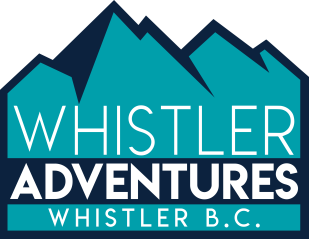Backcountry Skiing | Know Before You Go

You round a corner and a whole new world appears in front of you. Panoramic views of snowcapped peaks, rippling glaciers and clear blue skies stretch beyond the horizon. And not another soul for miles around. You’re exhausted. Out of breath, legs aching, sweating profusely. But wow, those views are worth it. And you know that the real fun is only just beginning.
You’re backcountry skiing in Whistler, and it promises to be a day you’ll never forget. Boundless world-class terrain, soft, west coast powder and your attentive, insightful guide come together to create something really special. Exploring Whistler’s backcountry skiing is a must for any keen skier visiting Whistler. Not only will you be treated to some of the best runs of your life, you’ll leave the chairlift lines far behind and venture out to experience the true wilderness of BC.
Planning a Whistler backcountry skiing trip takes some work. Choosing a route, reading the terrain, and understanding the avalanche risks are key to a successful (and safe) day in the backcountry. This article will provide you with some ideas to get you started.
If you’re planning to head out backcountry skiing, you need proper equipment, training and knowledge to do so safely. Which is why, if you’re unfamiliar with the area, we’d always recommend taking a professional guide. They’ll take the worry out of your day and their local knowledge will guarantee you some great descents.
What to Expect in the Whistler backcountry
Like the in-bounds skiing at Whistler Blackcomb, the backcountry skiing surrounding Whistler is some of the best in the world. With consistently high snowfall, a huge variety of terrain, and only two hours from Vancouver, it’s a sure bet for a great day out. Here are some key things you need to know to start planning your Whistler backcountry skiing trip.
- Where to Start
There is fantastic backcountry skiing on offer throughout the Sea to Sky corridor (and we’ll dig into some of our favourite routes later). Perhaps the simplest place to start is on Whistler Blackcomb. There are some classic runs on offer just outside the ski area boundary.
But make no mistake: you may have taken a chairlift earlier, but this is still the backcountry. Outside the boundary lines, no avalanche control takes place and you’re responsible for your own safety. So bring all the same equipment (shovel, probe and beacon) you would bring on any other backcountry adventure.
- Terrain
The skiable terrain around Whistler ranges from wide open powder bowls to playful treeline skiing to big mountain couloirs. This is the stuff of ski movies, and many of the world’s best skiers have honed their craft in these mountains. But there’s something here to suit everyone: whether you fancy a couple of quick, low-key laps or a challenging multi-day adventure. There’s also something to suit all conditions, which in coastal BC is a good thing, because….
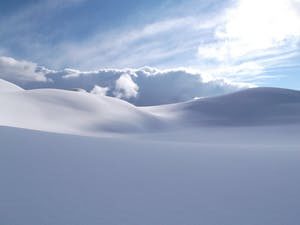
Research snow and avalanche conditions before you head out
- Weather and Snow Conditions
Whistler is blessed with consistently high snowfall year after year. Out in the backcountry, you’ll often find that fluffy powder sticks around for days after a storm. Which is good news for those who are prepared to work for it. That being said, being close to the Pacific, conditions can vary a lot in Whistler. We get bitingly cold snaps, brilliant sunshine and sometimes even get to enjoy an off-season rainstorm!
All this weather variation can do weird and wonderful things to the snowpack. So to ensure a fun, safe day, you’ll need to know what’s been happening to the snow, so you can choose the best (and safest) routes. Keep an eye on the Avalanche Canada bulletins, which provide informative and concise updates on snow conditions, risks and weather.
Why you Should hire a Backcountry Skiing Guide
If you’re visiting Whistler and planning a backcountry skiing trip, we would strongly recommend hiring a guide. There are lots of reasons why a knowledgeable local guide will enhance your day.
There’s also some serious reasons why a backcountry guide is vital if you have limited backcountry experience, or don’t know the area. The last few years have seen an explosion in backcountry skiing and snowboarding, and backcountry skiing in BC is no exception.
But just because it’s become more accessible, doesn’t mean the risks have changed. Here’s why we think a guide is a crucial part of a successful backcountry trip:
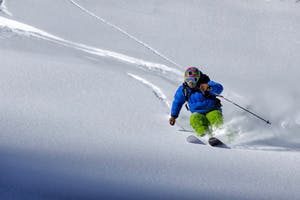
Backcountry ski guides, have your back in the mountains
-
Your Guide Understands Avalanche Risk
Outside of ski area boundaries, no runs are patrolled. That means that the vital avalanche control that ski patrollers carry out every day hasn’t been taken place. For backcountry skiers, the chances of being caught in, or setting off, an avalanche are much higher than skiing in-bounds.
And for backcountry skiers without the proper equipment, training, and understanding of the terrain, the risks get higher still. A guide will take away the worry by using their expertise to choose safe runs, make sensible choices and keep your group safe and having fun.
-
Your Guide Knows the Way Home
Another very important reason to hire a guide is that they know the area like the back of their hand. Let’s be honest, everything can start to look the same in the mountains after a while. And if you’re not familiar with the area, one wrong turn could land you in a lot of trouble. There are sadly many stories of skiers forced to spend an unplanned night outside when they’ve taken a wrong turn in the Whistler backcountry. And that’s got to be the worst way to end your epic backcountry adventure.
- Your Guide Loves the Whistler Backcountry
With the serious stuff out the way, there’s one more great reason to hire a backcountry guide: they love it here. These are not only expert skiers and skilled guides, they’re passionate locals who have spent years skiing these mountains. They know the best runs for all conditions, the secret powder stashes you’d never find yourself, and they’ll let you in on some locals’ tips and tricks too.
Book a Backcountry Skiing Guide
Whistler Adventures offers backcountry skiing and snowboarding packages that are tailored to you. Just show up with your skis, winter gear and your lunch, and we’ll do the rest. Our guide can create the perfect experience, whatever your ability level. We have access to some of the best backcountry skiing in Whistler, Blackcomb, Squamish and Duffey Lakes (more about these areas in a minute).
And we’ll provide you with all the safety information and equipment you need to stay safe and feel confident on your adventure. For the fit and ambitious among you, we can even offer multi-day trips, where you’ll stay in some of BC’s iconic backcountry huts in between once-in-a-lifetime ski days.
Top 5 Whistler Backcountry Destinations
You could ski the Whistler backcountry for a lifetime and never get bored. But here are a few of our favourite, classic Whistler backcountry routes that you should try on your trip:
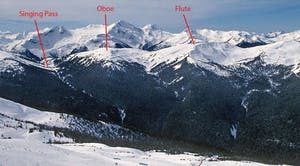
They are called the musical bumps for a reason
- Musical Bumps – Whistler Mountain
Some of the most accessible backcountry skiing in Whistler, the Musical Bumps are a range of rolling summits just above treeline. Access them by hiking to the top of Flute Summit (by Symphony chair) and heading out the backcountry gate (checking your beacon on the way). The Musical Bumps offer fun, playful descents without huge, exhausting ascents in between. Despite their proximity to the resort, you can still find great snow here even a few days after a storm. Come back in summer, and you’ll be able to see the Musical Bumps in a different light by hiking the stunning High Note Trail.
- D.O.A. – Blackcomb Mountain
The ominously named Dead On Arrival is a truly classic Whistler run. This couloir is not for the faint-hearted, but for those with the skills and commitment, it’s hugely rewarding. Steep and long, it can hold great snow and offers a long, thrilling descent. D.O.A. is accessed by the Blackcomb Glacier backcountry gate, followed by a relatively short skin to the summit.
- Duffey Lakes
To experience the true Whistler wilderness, hop in your car and head up to Duffey Lakes, between Pemberton and Lillooet. This area is home to big mountain summits like Mount Matier, Vantage Peak and Anniversary Glacier. These make for some fantastic full day adventures that feel truly wild, with few other souls for miles around. For experienced, fit backcountry skiers, these are bucket list descents you must fit into your trip.
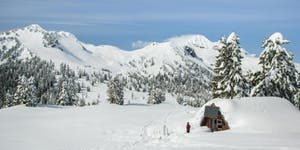
Arguably one of the most accessible backcountry areas around Whistler
- Elfin Lakes – Squamish
Another popular and well-loved area to ski tour is Elfin Lakes near Squamish. With a fairly mellow, straightforward ascent and one of the best backcountry huts in the area, Elfin Lakes is worth an overnight trip. There are plenty of descents to try out over a couple of days, including powder laps off Paul Ridge or the steep faces of the perfectly formed Diamond Head.
- Spearhead Traverse
Probably the most famous of all Whistler backcountry trips, and an aspirational goal for any passionate backcountry skier. The Spearhead Traverse links Whistler and Blackcomb peaks via a three-day traverse across the Spearhead glacier. Not a trip to be undertaken lightly, the Spearhead Traverse requires glacier travel skills and winter camping experience. But if you know what you’re doing, you’ll get to experience one of the most iconic backcountry ski trips in the world.
Whistler’s Backcountry Skiing: A trip to remember
With the right knowledge, equipment and a friendly guide by your side, a ski trip to the Whistler backcountry is an unforgettable experience. Knowing that you’ve really earned your turns make them all the sweeter. And backcountry skiing will show you the real wilderness at the heart of Whistler. Plus, you’ll feel like you really deserve your apres when you get back to Whistler. So book a trip today, and start preparing for this remarkable adventure.
